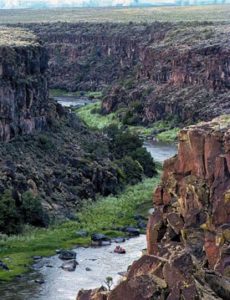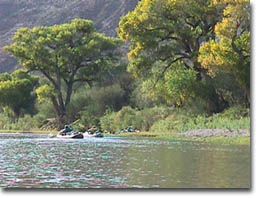 One of the New Mexico White Water Rafting rivers is the Rio Grande with a starting point at Taos, New Mexico. There is also the Chama river. You can enjoy the Taos box which is a remote chasm of cliffs that plunge 800 feet down to the Rio Grande. The Taos box is 17 miles of challenging rapids and is considered a class 4 rapids. Most of the rapids are class 3 on this 17 mile trip, however there are 2 class 4 rapids in this white water rafting trip down the Rio.
One of the New Mexico White Water Rafting rivers is the Rio Grande with a starting point at Taos, New Mexico. There is also the Chama river. You can enjoy the Taos box which is a remote chasm of cliffs that plunge 800 feet down to the Rio Grande. The Taos box is 17 miles of challenging rapids and is considered a class 4 rapids. Most of the rapids are class 3 on this 17 mile trip, however there are 2 class 4 rapids in this white water rafting trip down the Rio.
The Lower Gorge is a full day rafting adventure, with walls rising over 1500 feet from the floor of the Rio Grande Gorge. There are 7 class 3 rapids, some of which turn into class 4 rapids in high water season. There are also two class 2 rapids for paddlers to enjoy.
Chama river tours is another river trip that takes you past magnificent sandstone canyons and rock formations. Enjoy the 1500 foot cliffs that tower over the river along sections. Also enjoy the many colors from the flowers and cottonwood groves that line the bank of the Chama River.
Middle box canyon tour starts with a 1 mile hike down into the canyon. There are no roads into this area and only two companies are allowed into this area each day. Chances are you will see no other humans on this trip. There is one class 3 rapid on this trip while much of the trip is calm water with a few class 2 rapids sprinkled here and there.
Race course rapids on the Rio Grande provides two to three hours of class 2 and 3 rapids and is considered perfect for first time rafters and their families. There are 7 class 3 rapids, some of which turn into class 4 during high water season, and 2 class 2 rapids.
Orilla Verde white water rafting trips provide a mellow and scenic trip that is perfect for seniors and children and anyone who just wants to relax along the river. This tour has a class 2 rating which is very mild and calm compared to higher level class 3 and 4 rapids. The rafts are powered by the guide so you can just relax and enjoy the trip
White Canyon Rock is just west of Santa Fe, and it s full day trip including rafting on the river through spectacular canyons, and a run through a series of class 2 and 3 rapids. At the end of the trip you will hike up the canyon for 2 and a half miles to the pickup point. Guests are required to carry their own gear plus a flotation device and paddle.
New Mexico White Water Rafting – Companies
Several companies offer white water rafting trips on the Rio Grande and the Chama rivers during most of the season. They will offer half day trips, full day trips and over night trips camping out under the stars. If you are interested in one of these trips you should inquire what clothing to bring. Also ask what the physical requirements will be for one of these trips. Most rafting companies will provide all of the camping equipment including tents and food for tasty meals. You should inquire about sleeping bags and any other specialized gear that you may need.
If you are into mountain biking, some companies will also offer mountain biking and rafting combination tours. These trips are usually full day trips. Half a day is spent biking and half a day spent rafting with lunch served between the two.
Safety
There is always some risk to white water rafting , even the simple class 1 rapids. While you may not be required to swim to go on a rafting trip the risk is higher for non swimmers. Emergency procedures should be discussed prior to going on any trip. All rafters will be asked to sign a “liability release”. Rafters are required to wear a life jacket at all times. With class 4 rapids, you will also be asked to wear a helmet to protect your head in the event you are thrown from the raft.
Some rafting companies will also accommodate companion dogs on trips. However they must wear a canine floating device which you need to bring and they must be fully trained. Your companions must all be in excellent shape as well.
Rafting Guides
White water rafting guides need to have experience with the river you are on. They also need general experience to ensure your safety. They should be trained in river safety, swift water rescue, first aid and CPR. Before you sign up for any white water trip you should confirm experience levels . Also consider training levels in things like CPR for your own safety.
White Water grading
Rapids are graded from 6 which is considered un-runable to 1 which has barely a ripple. Class 2 is mostly flat water with gentle waves. A class 3 set of rapids can vary from moderate waves to more exciting boulder strewn whitewater. Class 4 is bigger and faster, more demanding than class 3. If you are planning on a trip the rating will be for the most demanding portion of the trip. If this is your first time, you may want to stick with a class 1 or 2 trip to get the feel of the experience. Higher classes of trips are more demanding. You may need to demonstrate that you can swim to safety in the event that you are toppled out of the raft.
White Water School
All guides must go through rafting school and local training prior to becoming a rafting guide. If you would like to become a guide , check with your local white water rafting company for more information.
For more posts about New Mexico rafting and more, click here.
 Two died, a mini van and two trucks , all lanes closed for four hours, east bound closed for more than 11 hours. We were Driving on I40 near Albuquerque and 8 miles from our destination for the night! We could not go anywhere and spent a lot of time sitting on the road without a whole lot of gas in the gas tank either. The following is a summary of a short chat we had with our kids about what happened to us.
Two died, a mini van and two trucks , all lanes closed for four hours, east bound closed for more than 11 hours. We were Driving on I40 near Albuquerque and 8 miles from our destination for the night! We could not go anywhere and spent a lot of time sitting on the road without a whole lot of gas in the gas tank either. The following is a summary of a short chat we had with our kids about what happened to us.

 Rafters can also put in at USFS Road 809 and take out at Redrock to cover 18 miles. A third location calls for put in at Redrock with a take out at Highway 92 bridge for a trip of 19 miles. Anyone floating down the river are cautioned to watch for trees that may have fallen into the river. Boats and rafts can get caught in the trees, and there is a chance you could capsize.
Rafters can also put in at USFS Road 809 and take out at Redrock to cover 18 miles. A third location calls for put in at Redrock with a take out at Highway 92 bridge for a trip of 19 miles. Anyone floating down the river are cautioned to watch for trees that may have fallen into the river. Boats and rafts can get caught in the trees, and there is a chance you could capsize. One of the New Mexico White Water Rafting rivers is the Rio Grande with a starting point at Taos, New Mexico. There is also the Chama river. You can enjoy the Taos box which is a remote chasm of cliffs that plunge 800 feet down to the Rio Grande. The Taos box is 17 miles of challenging rapids and is considered a class 4 rapids. Most of the rapids are class 3 on this 17 mile trip, however there are 2 class 4 rapids in this white water rafting trip down the Rio.
One of the New Mexico White Water Rafting rivers is the Rio Grande with a starting point at Taos, New Mexico. There is also the Chama river. You can enjoy the Taos box which is a remote chasm of cliffs that plunge 800 feet down to the Rio Grande. The Taos box is 17 miles of challenging rapids and is considered a class 4 rapids. Most of the rapids are class 3 on this 17 mile trip, however there are 2 class 4 rapids in this white water rafting trip down the Rio.